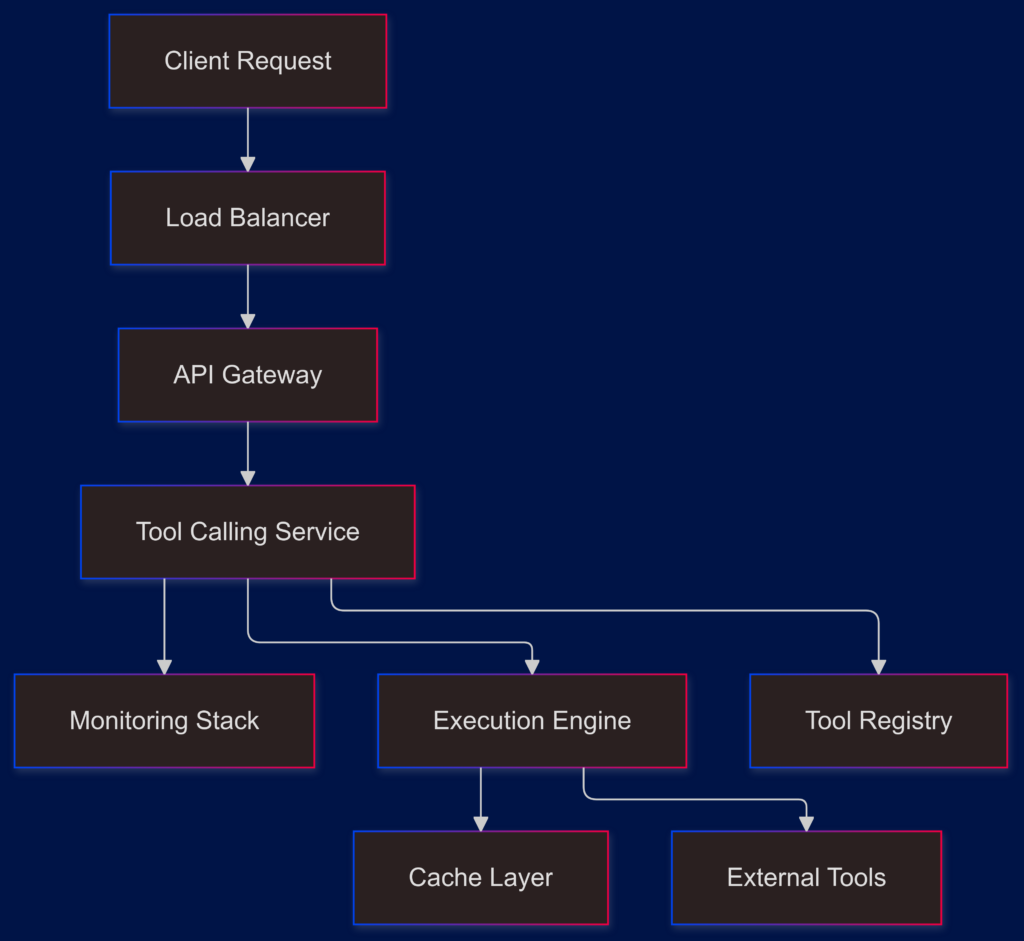Tool Calling for LLMs: Foundations and Architectures is revolutionizing how developers extend the capabilities of large language models (LLMs). By enabling seamless interaction with external systems like APIs, databases, and custom tools, tool calling transforms LLMs into interactive agents capable of handling real-world tasks. This article delves into the core concepts, system architectures, and practical implementation strategies necessary for building robust tool-calling systems.
2. Core Concepts
Tool calling bridges the gap between LLMs and external tools. By using structured definitions, tool calling allows LLMs to:
- Fetch live data.
- Perform computations.
- Generate actionable insights.
High-Level Benefits:
- Dynamism: Real-time interaction with external systems.
- Precision: Guided execution reduces hallucinations.
- Extendibility: Easily integrate new tools and workflows.
3. System Architectures
3.1 Overview
The architecture involves several key components: client requests, tool dispatching, execution engines, and monitoring systems.

3.2 Key Components
- Tool Registry: Stores tool definitions and metadata.
- Execution Engine: Executes tool calls and handles caching, retries, and logging.
- Monitoring Stack: Tracks performance, errors, and system health.
4. Advanced Tool Definitions
Effective tool definitions are essential for robust tool calling. A comprehensive definition includes:
- Metadata: Name, description, and version.
- Parameters: Input constraints and types.
- Outputs: Schema for returned data.
- Error Handling: Strategies for retries and fallback logic.
Example: Currency Converter Tool
{
"name": "CurrencyConverter",
"description": "Converts amounts between currencies using live exchange rates.",
"parameters": {
"amount": {"type": "float", "description": "Amount to convert."},
"from_currency": {"type": "string", "description": "Source currency code."},
"to_currency": {"type": "string", "description": "Target currency code."}
},
"output": {
"type": "json",
"schema": {"converted_amount": "float", "rate": "float"}
},
"error_handling": {
"validation_error": {"code": "INVALID_INPUT", "retry_strategy": "none"},
"api_failure": {"code": "SERVICE_UNAVAILABLE", "retry_strategy": "exponential_backoff"}
}
}5. Integration with Industry-Standard Frameworks
5.1 LangChain Integration
LangChain simplifies tool calling by chaining LLMs and tools.
Example: Currency Conversion
from langchain.tools import Tool
from langchain.llms import OpenAI
from langchain.chains import ToolUsingChain
def convert_currency(amount, from_currency, to_currency):
exchange_rate = 0.84 if from_currency == "USD" else 1.19
return {"converted_amount": amount * exchange_rate, "rate": exchange_rate}
currency_tool = Tool(
name="CurrencyConverter",
description="Convert currency values.",
func=convert_currency
)
llm = OpenAI(model="gpt-4")
chain = ToolUsingChain(llm=llm, tools=[currency_tool])
response = chain.run("Convert 100 USD to EUR")
print(response)5.2 OpenAI Integration
Using OpenAI’s function calling API.
import openai
tools = {"fetch_weather": lambda city: {"temperature": "25°C", "condition": "Clear"}}
def handle_openai_tool_call(prompt, tools):
tool_def = {"name": "fetch_weather", "parameters": {"city": {"type": "string"}}}
response = openai.ChatCompletion.create(
model="gpt-4",
messages=[{"role": "user", "content": prompt}],
functions=[tool_def],
function_call="auto"
)
tool_call = response.choices[0].message.get("function_call")
if tool_call:
tool_name = tool_call["name"]
arguments = eval(tool_call["arguments"])
return tools[tool_name](**arguments)
return responseConclusion
Tool calling transforms Large Language Models (LLMs) from static responders into dynamic, context-aware agents capable of integrating with external systems. In this article, we explored the foundational concepts, core architectures, and practical integration techniques that enable this transformation. From defining tools with precision to integrating with frameworks like LangChain and OpenAI, you now have a strong foundation to implement tool calling in your projects.
However, implementing tool calling in a production environment presents unique challenges. Ensuring scalability, reliability, and security requires advanced strategies and robust error recovery mechanisms.
In the next part of this series, we’ll dive deeper into production strategies, such as distributed execution, observability, and performance optimization. We’ll also explore real-world applications of tool calling, from customer support chatbots to financial trading bots, illustrating how these concepts power cutting-edge systems.
Stay tuned as we bridge the gap between theoretical understanding and practical, production-ready systems in Part 2: Production Strategies and Real-World Applications of Tool Calling.





Leave a Reply